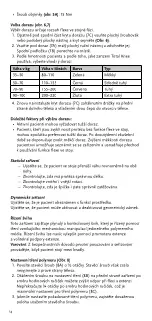
8
• Proximal Adapter Pinch Bolt
(Fig. 1E)
: Please refer to the respective
proximal adapter’s instructions for use.
• Tube Clamp Screw
(Fig. 5A)
: 15 Nm
Bumper Selection (Fig. 6,7)
The selection of a bumper determines the amount of stance flexion.
1. Carefully insert a flat head screwdriver or a similar flat tool under the
bottom of the Bumper Cover (7C) and remove it
(Fig. 6)
.
2. Remove the Bumper (7A) by inserting a small and flat hand tool
underneath it and lift upwards. Leave the underlying Shim (7B) in
place.
3. Select a Bumper to install based on which Total Knee device is being
used, and on the patient’s weight:
Weight kg
Weight lbs
Color
Type
35–50
80–110
Green
Soft
50–70
110–155
Black
Regular
70–90
155–200
Red
Firm
90–100
200–220
Yellow
Extra Firm
4. Re-install the Bumper Cover (7C) by hooking the groove under the
chassis front and pushing the two pins into the chassis holes.
Influencing Factors on Bumper Selection:
• Active patients may require a stiffer bumper.
• Patients who are accustomed to wearing a prosthesis without a
stance-flexion feature may initially prefer a stiffer Bumper. After a trial
period of two weeks, selecting a softer Bumper is recommended.
Increasing the softness of the Bumper allows the patient to get
familiarized with the device and facilitates the transition to using its
stance-flexion feature.
Static Alignment
– Make sure the patient stands with equal weight on both legs.
– Check for correct prosthesis length.
– Check internal / external rotation.
– Check for correct load on toe and heel.
Dynamic Alignment
Ensure the patient is familiar with the functioning of the device.
Ensure the patient can activate and deactivate the geometric lock.
Swing Control
The device is designed to provide smooth and fluid friction swing control
through the mechanical manipulation of a unique polymer medium.
Additionally, the swing control can be enhanced by using the Extension
Promoter and optional Extension Assist.
Caution:
For safety, please make initial assessments and adjustments
with the patient standing between parallel bars.
Polymer Friction Adjustment (Fig. 8)
1. Loosen the Set Screw (8A) by a ½ turn. Do not completely remove the
Set Screw from the right side of the device’s housing unit.
Summary of Contents for TOTAL KNEE 1900
Page 1: ...Instructions for Use TOTAL KNEE 1900...
Page 3: ...3 B D E C A 1 2 3 A 4 5 B D C E A 5 6 A B D C 7...
Page 4: ...4 I A B C E G F H D B A C A B C A 8 9 10 11...
Page 45: ...45 7A 7D 100...
Page 48: ...48 8 1 8A 2 8 8C 3 2 Nm 17 in lbs 7B 7A 0 38 0 76...
Page 49: ...49 7D 9 1 A B C 2 D E 3 4 F G 5 H 6...
Page 50: ...50 7 E H 8 15 50 6 10A 11 12...
Page 51: ...51 ssur 11A 11B 11C 12 12B ssur ISO 10328 3 5 ISO 10328 P5 100 kg...























